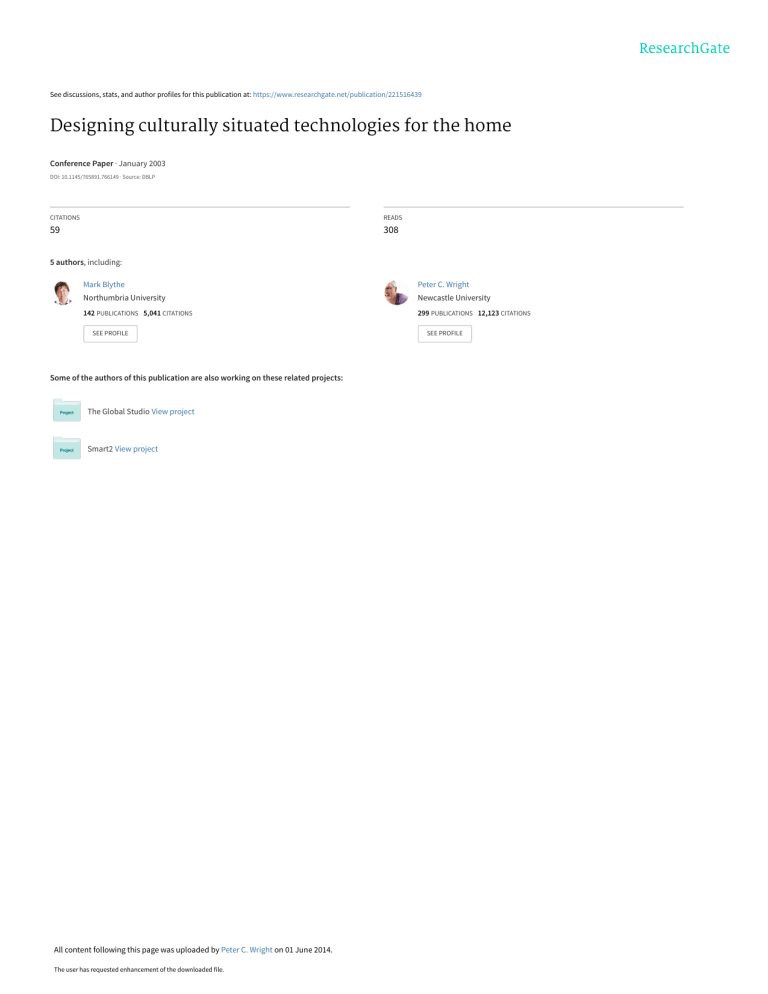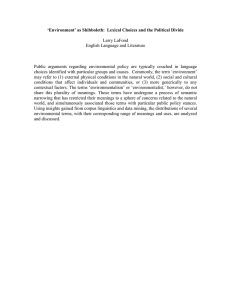
See discussions, stats, and author profiles for this publication at: https://www.researchgate.net/publication/221516439 Designing culturally situated technologies for the home Conference Paper · January 2003 DOI: 10.1145/765891.766149 · Source: DBLP CITATIONS READS 59 308 5 authors, including: Mark Blythe Peter C. Wright Northumbria University Newcastle University 142 PUBLICATIONS 5,041 CITATIONS 299 PUBLICATIONS 12,123 CITATIONS SEE PROFILE Some of the authors of this publication are also working on these related projects: The Global Studio View project Smart2 View project All content following this page was uploaded by Peter C. Wright on 01 June 2014. The user has requested enhancement of the downloaded file. SEE PROFILE CHI 2003: NEW HORIZONS Workshops Designing Culturally Situated Technologies for the Home Genevieve Bell* , Mark Blythe#, Bill Gaver+, Phoebe Sengers~ and Peter Wright** *Intel Research University of York +Royal College of Art ~Cornell Corporate Technology #Dept of Psychology / Kensington Gore Information Science Group **Computer Science London Ithaca, Hillsboro, OR 97124 York, YO10 5DD, UK SW7 2EU UK NY 14850 USA This workshop will explore ways to design domestic technology by incorporating an awareness of cultural context, accrued social meanings, and user experience. THE SOCIAL CONTEXT OF TECHNOLOGY Understanding how users experience technologies necessitates a concern with social and cultural meaning: what does the product mean to the user, what does it mean in the context of particular cultures, and what does it mean in terms of its broad impacts on the social and global environment? Through the ownership and use of particular technologies and artifacts, we make statements about ourselves and our values [3]. In the design, production, and marketing of new digital technologies, we also naturalise and normalise certain kinds of social interactions and values. Nowhere is this clearer than in the home, which is widely recognised as a unique and diverse design environment with complex and sometimes contradictory requirements [7]. As settings for interaction, homes are even more than workplaces not the same everywhere: they do not look the same, they are not inhabited by the same social units, and they are not lived in in the same ways. Different countries and cultures vary enormously in distinctions between private and public spaces, senses of place over space, the rhythms of daily routines, the relationships between self, place and others, and the porousness of the home’s boundaries [1]. This diversity makes it clear that our current understanding of user needs analysis, derived from the world of work and limited studies of (largely) western homes, is not adequate to this new design challenge. USER EXPERIENCE AND MEANING This workshop is grounded in recent HCI concerns with user experience and the ways in which technology can take on social meaning. Work in this area often draws on the work of social scientists and humanists like Sherry Turkle [15], who explores the social meaning of computers, the culture of computing and its impact on our sense of self in the age of the internet. Brenda Laurel applies the analysis of meaning to technology design by exploring the metaphor of computer not as tool but as theatre, arguing that engagement in computer-mediated activity is as much about emotional and aesthetic relations as it is about rational and intellectual ones [10]. This focus on aesthetics and a sense of experience has become influential in the design of computational artifacts and interfaces: leading proponents of standard usability testing such as Jakob Nielsen have addressed the importance of fun and pleasure; Don Norman goes so far as to argue that, in the right context, “Attractive things work better” [11]. As new technologies are adopted and adapted in the home, they change and are changed by the social relations that they mediate. Because of this, social responsibility may be essential in the design of domestic technology and require an understanding of the meanings of domestic technology in its social context. The potential situated meanings of domestic technology are fluid and multiple, connecting with a range of discourses such as work, leisure, class, religion, age, ethnicity, sex, identity, success. Meaning may also be embodied in artefacts through the historical contexts of use. Up until relatively recently, for instance, running and maintaining a home in the West was “women’s work” and home appliances are loaded with cultural associations formed around the gendered division of domestic labour [14]. Labour-saving devices and entertainment technologies may privatise domestic space and isolate household members from one another. Household work that once was shared is now mechanised and performed invisibly by lone individuals; home entertainments are distributed throughout the home so that formerly communal activities become individual acts of consumption [8]. Further, technological developments affect the wider contexts of neighbourhoods and communities. Local communities may be eroded at the same time that global communities are formed. NEW CONTEXTS FOR TECHNOLOGY DESIGN As digital technologies proliferate in the home, the HumanComputer Interaction (HCI) community has turned its attention from the workplace and productivity tools towards domestic design environments and non-utilitarian activities [12]. In the workplace, applications tend to focus on productivity and efficiency and involve relatively wellunderstood requirements and methodologies, but in domestic design environments we are faced with the need to support new classes of activities. While usability is still central to the field, HCI is beginning to address other considerations such as pleasure, fun, emotional effect, aesthetics, the experience of use, and the social and cultural impact of new technologies [e.g 2,4,5,6,9]. These considerations are particularly relevant to the home, where technologies are situated or embedded within an ecology that is rich with meaning and nuance. Copyright is held by the author/owner(s). Copyright is held by the author/owner(s). CHICHI 2003, April 5-10, 2003, Ft. Lauderdale, Florida, USA. 2003, April 5–10, 2003, Ft. Lauderdale, Florida, USA. ACM 1-58113-637-4/03/0004 ACM 1-58113-630-7/03/0004. 1062 CHI 2003: NEW HORIZONS Workshops INTEGRATING DESIGN AND SOCIAL ANALYSIS Techniques. The adaptation of analytical techniques from fields such as anthropology and literary and cultural studies for exploring the cultural assumptions that are embodied in domestic technology. There is a burgeoning technical literature on the development of a wide variety of computing devices for the home based on new possibilities in embedded, mobile, and tangible computing. There is also a wide literature from a variety of fields that explores the rich social, cultural, and historical dimensions of home life and the role that technology does and can play in it. The premise of this workshop is that these two perspectives on domestic technology can inform each other to lead to new, better, more appropriate, and more interesting technologies for the home. Culturally Sensitive Design. Methods and techniques for designing domestic technology suitably for non-western cultures. We encourage participation from a wide range of disciplines including computer science, product design, psychology, social sciences, and cultural studies. REFERENCES EXTENDING THE INTERDISCIPLINARY NET 1. Bell, G. Looking Across the Atlantic: Using Ethnographic Methods to Make Sense of Europe. Intel Technical Journal, Q3, 2001. HCI already draws on non-engineering disciplines such as ethnography and design in order to better understand experience and aesthetics in technology design. Humanitiesbased disciplines such as anthropology, literary, and cultural and media studies could provide an additional range of techniques and methods for understanding how we relate to and think about technologies as cultural artifacts. This workshop will explore the extent to which these disciplines can be used to develop innovative approaches to design through deeper understandings of the social and cultural meanings of domestic technologies. Critical readings of the social context of use and the codification of meaning can generate innovative suggestions for and approaches to design problems. For example, the Viridian design movement recently sponsored a contest to design an aesthetic electrical meter that would pleasurably inform consumers about their electricity use [13]. This workshop will consider the extent to which designers can or should manipulate the meanings of their technologies in such socially responsible ways. 2. Blythe, M. and A. Monk. Notes Towards An Ethnography of Domestic Technology. In Proceedings of DIS2002. ACM Press, 2002. 3. Csikszentmihalyi, M. The Meaning of Things: Domestic Symbols and the Self. Cambridge: Cambridge UP, 1981 4. Dunne, A. Hertzian Tales: Electronic Products, Aesthetic Experience and Critical Design. London: RCA Press, 1999. 5. Gaver, W. and A. Dunne. Projected Realities: Conceptual Design for Cultural Effect. Proceedings of CHI '99, ACM Press, 1999. 6. Gaver, B. and H. Martin. Alternatives: Exploring information appliances through conceptual design proposals. Proceedings of CHI 2000. pp 209-216. ACM Press, 2000. 7. Hindus, D., S. Mainwaring, A.E. Hagstrom, N. Leduc, and O. Bayley. Casablanca: Designing Social Communication Devices for the Home. Proceedings of CHI ‘01. ACM Press, 2001. GOALS OF THE WORKSHOP This workshop has the following aims: • To bring together a multi-disciplinary group of researchers and practitioners interested in domestic technology and particularly in how the social and cultural meanings of domestic technologies do, can, or should affect how we design; 8. Hardyment, C. From Mangle to Microwave. Oxford: Polity Press, 1988. 9. Jordan, P.W. Designing Pleasurable Products: An Introduction to the New Human Factors. Taylor and Francis, 2000 • To develop an agenda for collaboration and research in user experience, meaning and design of home technology; 10. Laurel, B. Computers as Theatre. Addison-Wesley Publishing Company, 1993. • To identify specific recommendations about how companies and research funders can develop innovative approaches to design through deeper understandings of the social and cultural meanings of domestic technologies. 11. Norman, D. Emotion and Design: Attractive Things Work Better, Interactions. Volume IX.4. July + August 2002. We plan to cover the following general topics: 12. Preece J, Rogers Y, and H. Sharp. Interaction Design: Beyond Human-Computer Interaction. Wiley, 2002. Theory: The ways in which cultural and social analysis can augment traditional approaches to user experience in informing the design of new digital products. 13. Scanlon, J. Power Players. Wired 9(1), 2001. 14. Strasser, S. Never Done: A History of American Housework. NY: Pantheon, 1982. Findings. Experimental or field studies of home life that present challenges to traditional interaction design. 15. Turkle, S (1996): Life on the Screen: Identity in the Age of the Internet Simon and Schuster, New York. Practice. Case studies of home based digital products and domestic technologies that address cultural issues in the home, such as gender imbalance in housework. 1063 View publication stats

![Word Study [1 class hour]](http://s3.studylib.net/store/data/007905774_2-53b71d303720cf6608aea934a43e9f05-300x300.png)


